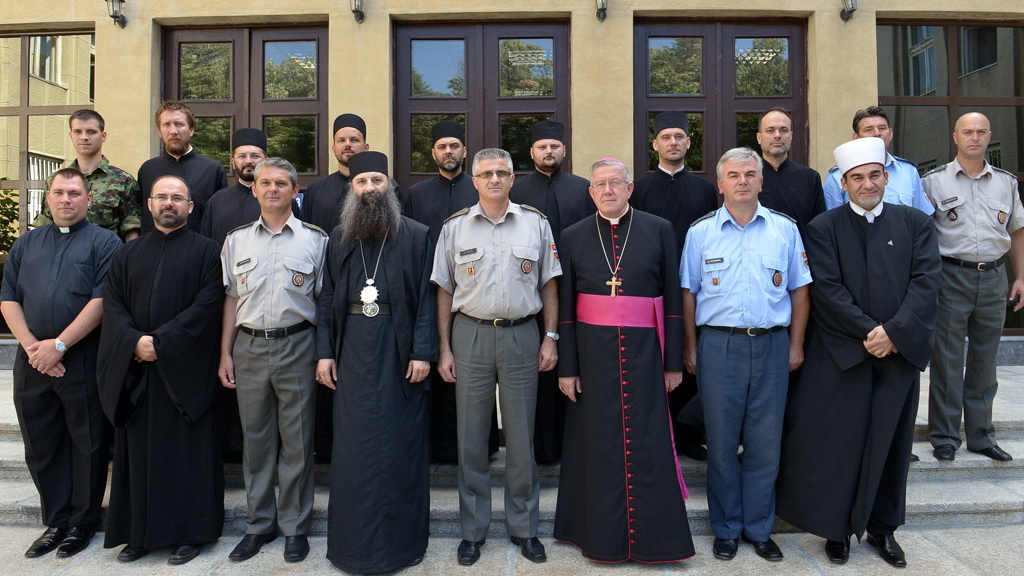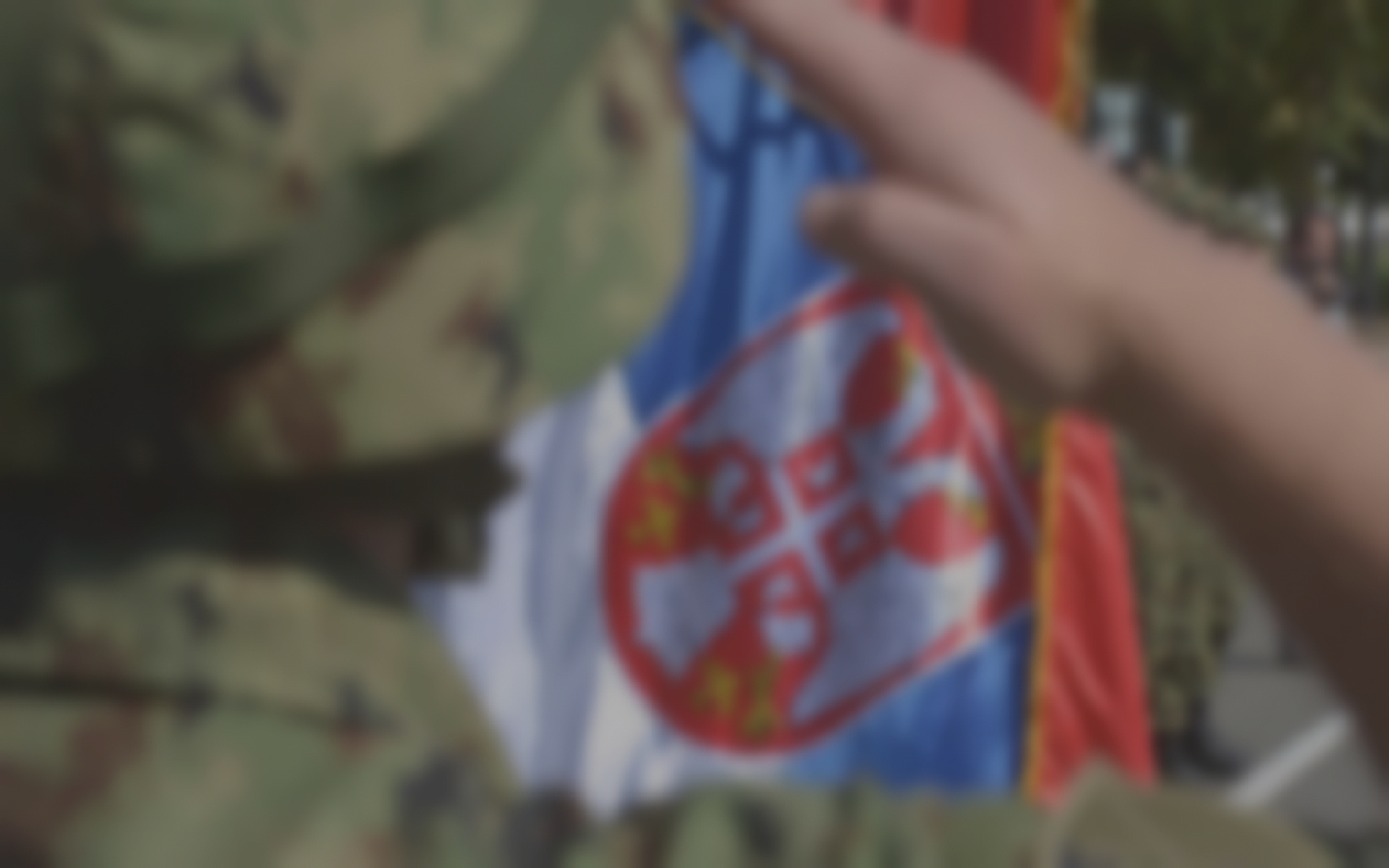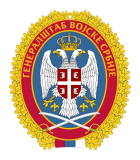Chaplaincy Service in the SAF
The Chaplaincy Service is an organized form of the activities of the traditional churches and religious communities in the military environment, and includes activities of religious service in the Serbian Armed Forces.

The purpose of the Chaplaincy Service is to secure the constitutional rights of the Serbian Armed Forces personnel to exercise the freedom of religion, which is done exclusively on the basis of free will and beliefs, voluntarily, while observing the obligations arising from the military service.
The task of Chaplaincy Service is to develop and strengthen spiritual and moral values of the Serbian Armed Forces, foster military virtues, patriotism, and civic responsibility. The Chaplaincy Service acts in the function of building, maintaining and increasing the operational capability of the Serbian Armed Forces in performing all defined missions and tasks.
Chaplaincy service includes liturgical and other religious activities.
Liturgical activities in the Serbian Armed Forces include liturgies and religious rites. They are performed publicly by the Chaplains and Chaplaincy personnel in religious service facilities.
Other Chaplaincy activities are performed by Chaplains and Chaplaincy personnel as staff officers in the commands of the units and establishments of the Ministry of Defence and the Serbian Armed Forces.
Chaplains and Chaplaincy personnel are clerics, that is, spiritual leaders of the traditional churches and religious communities that perform the religious service in the Serbian Armed Forces as professional military personnel with the status of the Serbian Armed Forces officers. In accordance with the law and the agreements concluded with the traditional churches and religious communities, and depending on what church or religious community they belong to, they are called Military Priest, Military Chaplain, Military Imam and Military Rabbi.
Chaplains and Chaplaincy Service were first mentioned in the first half of the 19th century and have been constantly present in the military until the mid-20th century.
Chaplains and Chaplaincy Service in the military units were regulated by two legal Acts in the Principality of Serbia, both from 1839. The first one is the Act on Establishment of Garrison Army (May 31), and the second is the Act on the Military (October 31). The chaplains performed religious rites in the units and professed Christian values with personal example. The status of the military, and thus its Chaplaincy Service was prescribed by the Act on Establishment of the Standing Army (1860) and the Act on the Establishment of National Army (1861), but the legislation enacted on February 24, 1876, on the eve of the war with the Turks, the Act on the Establishment of the Entire Army included most of the stipulations regulating the Chaplaincy Service. Chaplains were assigned to the Supreme Headquarters, division and brigade HQs. It was stipulated that the Military Bishop had his place in the Supreme Command and he was responsible for the overall Military Chaplaincy.
Chaplains had the status of government officials, with benefits identical to those that the officers had. Special attention was paid to the religion teaching, which was mandatory for all soldiers and cadets of the Junior Military Academy.
In war time, the place of Chaplains was determined by the Chief of the General Staff, and his duties were to ensure that all priests were in the appropriate places for prayer, to boost the soldiers’ morale and thus strengthen the combat readiness, civil responsibility and finally to offer the holy communion to the dying.
Serbian military also had a certain number of military imams and military rabbis, who performed their duties enjoying a fully equal status as the Orthodox priests. Roman Catholic Chaplains were introduced for the first time in the Serbian Army on the Salonika Front, on the initiative of the Serbian Metropolitan Dimitrije, to ensure the freedom of religion to the Austro-Hungarian prisoners of war.
The Armed Forces of the Kingdom of Serbs, Croats and Slovenes, later the Kingdom of Yugoslavia, retained the same form of Chaplaincy organization that had existed in the Serbian Army until 1918. All recognized churches and religious communities had the right to nominate their chaplains, due to the multiethnic and multi-confessional character of the new state. The Chaplaincy Service was abolished after the end of the Second World War.
Chaplaincy Service in the Serbian Armed Forces is organized on the basis of the Act on the Serbian Armed Forces, which came into force on January 1, 2008, when the legal requirements for more detailed regulation of this area were met.
Pursuant to the Act, the Serbian Government regulated the issues concerning the exercise of the freedom of religion by the Serbian Armed Forces Personnel with the Regulation on Chaplaincy Service in the Serbian Armed Forces, on March 24, 2011.
Act on the Serbian Armed Forces also defined that the mutual relations between the Ministry of Defence and the churches and religious communities, concerning the Chaplaincy Service in the Serbian Armed Forces would be regulated through special agreements.
The Agreement between the Ministry of Defence and the Holy Synod of the Serbian Orthodox Church was signed on June 28, 2011 and agreements with the six remaining traditional churches and religious communities (the Roman Catholic Church in Serbia, the Slovak Evangelical Church, Reformed Christian Church, the Evangelical Christian Church, the Jewish community in Serbia and the Islamic community in Serbia) were signed on October 18, 2011. Signing the agreement enabled the implementation of the Regulation on Chaplaincy Service in the Serbian Armed Forces.
On the basis of the Regulation on Chaplaincy Service in the Serbian Armed Forces and agreements with churches and religious communities, the Code on the conditions for exercising the Chaplaincy activities in the Serbian Armed Forces was drafted, which more closely regulates the conditions for the exercise of liturgical and religious rites and other religious activities of Chaplains, Chaplaincy Service personnel and Assistant Chaplains.
Number of chaplains and Chaplaincy Service personnel is determined on the basis of the number of believers of a particular confession in the Serbian Armed Forces, in accordance with the Code on the conditions for exercising the Chaplaincy activities in the Serbian Armed Forces and Agreements with churches and religious communities.
In accordance with the principle of adequate religious representation in the Ministry of Defence and the Serbian Armed Forces, the number of jobs for Chaplains and Chaplaincy personnel is defined by formation as follows: 26 Military Priests of the Serbian Orthodox Church, 1 Military Chaplain of the Roman Catholic Church and 1 Military Imam from the Islamic Community of Serbia.
The Chaplaincy Service in the Serbian Armed Forces is organized at the General Staff level, as the Chaplaincy Section of the Human Resources Department with the following composition: Head of the Section, a Desk Officer, the Chief Military Priest, the Chief Military Chaplain, the Chief Military Imam, the Assistant Chief Military Priest, the Assistant Chief Military Chaplain, and the Assistant Chief Military Imam.
In the establishments of the Ministry of Defence, operational level Commands, brigade level units HQs and in some battalion HQs, the Chaplaincy Service is formally organized in Groups for Chaplaincy Affairs. A Group consists of a Chaplain and his assistant.
A religious service place in the Serbian Armed Forces is a specially dedicated and equipped facility for religious service in barracks, military facilities and other places where Serbian Armed Forces personnel perform their missions and tasks, in accordance with the autonomous regulations of the traditional church or the religious community.
Religious service and rites can also be performed outside the liturgical facilities and military establishment, if requested by the Serbian Armed Forces personnel or proposed by the Chaplain or the Chaplaincy official, and if it is approved by the responsible commander, with agreement of the official cleric.
41 rooms in the Ministry of Defence and the Serbian Armed Forces are planned to be arranged as religious service places for Orthodox Christians, as well as two rooms for Riman Catholics and three rooms for Muslims.
The task of Chaplaincy Service is to develop and strengthen spiritual and moral values of the Serbian Armed Forces, foster military virtues, patriotism, and civic responsibility. The Chaplaincy Service acts in the function of building, maintaining and increasing the operational capability of the Serbian Armed Forces in performing all defined missions and tasks.
Chaplaincy service includes liturgical and other religious activities.
Liturgical activities in the Serbian Armed Forces include liturgies and religious rites. They are performed publicly by the Chaplains and Chaplaincy personnel in religious service facilities.
Other Chaplaincy activities are performed by Chaplains and Chaplaincy personnel as staff officers in the commands of the units and establishments of the Ministry of Defence and the Serbian Armed Forces.
Chaplains and Chaplaincy personnel are clerics, that is, spiritual leaders of the traditional churches and religious communities that perform the religious service in the Serbian Armed Forces as professional military personnel with the status of the Serbian Armed Forces officers. In accordance with the law and the agreements concluded with the traditional churches and religious communities, and depending on what church or religious community they belong to, they are called Military Priest, Military Chaplain, Military Imam and Military Rabbi.
Background
Chaplains and Chaplaincy Service were first mentioned in the first half of the 19th century and have been constantly present in the military until the mid-20th century.
Chaplains and Chaplaincy Service in the military units were regulated by two legal Acts in the Principality of Serbia, both from 1839. The first one is the Act on Establishment of Garrison Army (May 31), and the second is the Act on the Military (October 31). The chaplains performed religious rites in the units and professed Christian values with personal example. The status of the military, and thus its Chaplaincy Service was prescribed by the Act on Establishment of the Standing Army (1860) and the Act on the Establishment of National Army (1861), but the legislation enacted on February 24, 1876, on the eve of the war with the Turks, the Act on the Establishment of the Entire Army included most of the stipulations regulating the Chaplaincy Service. Chaplains were assigned to the Supreme Headquarters, division and brigade HQs. It was stipulated that the Military Bishop had his place in the Supreme Command and he was responsible for the overall Military Chaplaincy.
Chaplains had the status of government officials, with benefits identical to those that the officers had. Special attention was paid to the religion teaching, which was mandatory for all soldiers and cadets of the Junior Military Academy.
In war time, the place of Chaplains was determined by the Chief of the General Staff, and his duties were to ensure that all priests were in the appropriate places for prayer, to boost the soldiers’ morale and thus strengthen the combat readiness, civil responsibility and finally to offer the holy communion to the dying.
Serbian military also had a certain number of military imams and military rabbis, who performed their duties enjoying a fully equal status as the Orthodox priests. Roman Catholic Chaplains were introduced for the first time in the Serbian Army on the Salonika Front, on the initiative of the Serbian Metropolitan Dimitrije, to ensure the freedom of religion to the Austro-Hungarian prisoners of war.
The Armed Forces of the Kingdom of Serbs, Croats and Slovenes, later the Kingdom of Yugoslavia, retained the same form of Chaplaincy organization that had existed in the Serbian Army until 1918. All recognized churches and religious communities had the right to nominate their chaplains, due to the multiethnic and multi-confessional character of the new state. The Chaplaincy Service was abolished after the end of the Second World War.
Legal Framework
Chaplaincy Service in the Serbian Armed Forces is organized on the basis of the Act on the Serbian Armed Forces, which came into force on January 1, 2008, when the legal requirements for more detailed regulation of this area were met.
Pursuant to the Act, the Serbian Government regulated the issues concerning the exercise of the freedom of religion by the Serbian Armed Forces Personnel with the Regulation on Chaplaincy Service in the Serbian Armed Forces, on March 24, 2011.
Act on the Serbian Armed Forces also defined that the mutual relations between the Ministry of Defence and the churches and religious communities, concerning the Chaplaincy Service in the Serbian Armed Forces would be regulated through special agreements.
The Agreement between the Ministry of Defence and the Holy Synod of the Serbian Orthodox Church was signed on June 28, 2011 and agreements with the six remaining traditional churches and religious communities (the Roman Catholic Church in Serbia, the Slovak Evangelical Church, Reformed Christian Church, the Evangelical Christian Church, the Jewish community in Serbia and the Islamic community in Serbia) were signed on October 18, 2011. Signing the agreement enabled the implementation of the Regulation on Chaplaincy Service in the Serbian Armed Forces.
On the basis of the Regulation on Chaplaincy Service in the Serbian Armed Forces and agreements with churches and religious communities, the Code on the conditions for exercising the Chaplaincy activities in the Serbian Armed Forces was drafted, which more closely regulates the conditions for the exercise of liturgical and religious rites and other religious activities of Chaplains, Chaplaincy Service personnel and Assistant Chaplains.
Chaplains and Chaplaincy Personnel
Number of chaplains and Chaplaincy Service personnel is determined on the basis of the number of believers of a particular confession in the Serbian Armed Forces, in accordance with the Code on the conditions for exercising the Chaplaincy activities in the Serbian Armed Forces and Agreements with churches and religious communities.
In accordance with the principle of adequate religious representation in the Ministry of Defence and the Serbian Armed Forces, the number of jobs for Chaplains and Chaplaincy personnel is defined by formation as follows: 26 Military Priests of the Serbian Orthodox Church, 1 Military Chaplain of the Roman Catholic Church and 1 Military Imam from the Islamic Community of Serbia.
The Chaplaincy Service in the Serbian Armed Forces is organized at the General Staff level, as the Chaplaincy Section of the Human Resources Department with the following composition: Head of the Section, a Desk Officer, the Chief Military Priest, the Chief Military Chaplain, the Chief Military Imam, the Assistant Chief Military Priest, the Assistant Chief Military Chaplain, and the Assistant Chief Military Imam.
In the establishments of the Ministry of Defence, operational level Commands, brigade level units HQs and in some battalion HQs, the Chaplaincy Service is formally organized in Groups for Chaplaincy Affairs. A Group consists of a Chaplain and his assistant.
Religious Service Facilities
A religious service place in the Serbian Armed Forces is a specially dedicated and equipped facility for religious service in barracks, military facilities and other places where Serbian Armed Forces personnel perform their missions and tasks, in accordance with the autonomous regulations of the traditional church or the religious community.
Religious service and rites can also be performed outside the liturgical facilities and military establishment, if requested by the Serbian Armed Forces personnel or proposed by the Chaplain or the Chaplaincy official, and if it is approved by the responsible commander, with agreement of the official cleric.
41 rooms in the Ministry of Defence and the Serbian Armed Forces are planned to be arranged as religious service places for Orthodox Christians, as well as two rooms for Riman Catholics and three rooms for Muslims.


